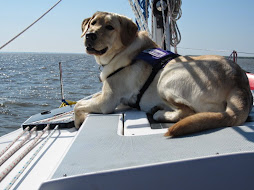SSD Gideon watches his handler, then turns his head and looks away. Click. He immediately turns back to his handler and receives a treat. Now, standing and watching his handler, he tries to figure out what behavior got him the click. He cocks his head to the side, still maintaining eye contact. No click. He turns his head to the side and breaks eye contact. Click. He turns back for his treat. This time, he immediately turns his head to the side and looks away. Click. He gets another treat.
In this illustration, SSD Gideon, one of SSD's demo dogs, quickly learned that turning his head and looking away gained him the click and subsequent treat, and he learned this behavior without any cues from his handler other than the clicker.
SSD uses clicker training, and we've been very successful with it. Not only do we have fun with it, but the dogs have fun, too! Clicker training becomes a fun game for them - a game where they learn the good manners and behaviors that make them great service dogs.
So far in this series, we've talked about training yourself in clicker training before training your dog. We've shared several exercises you can practice to help you master treat delivery and timing. Now you're ready to try clicker training with your dog. We'd like to share some of the techniques that we use when we're clicker training our dogs.
Start Small
When you first start clicker training with your dog, think small. Chose a behavior your dog will probably do on his own, such as sit or come. Start clicking the instant he performs that behavior and give him a treat so he associates the click with a treat.
Keep your clicker training sessions short, about 5 minutes each. You know how your mind starts to wander during a long lecture and you stop learning as much? A similar thing will happen with your dog if you try to clicker train him for one long sesson. Break it up and work the short, 5-minute sessions into your daily routine. You dog will learn more and have more fun doing it.
Build up to the complete behavior. Click and treat for small movements in the right directions. You don't have to wait for your dog to give you the complete, perfect behavior before you click. Let's say you want your dog to lie down. Start by clicking any movement your dog makes toward the floor and gradually work up to a full down. After a while, when your dog is voluntarily giving you the full behavior, start asking for more. For instance, once your dog gives you a full down, make him stay down for a few extra seconds before clicking. This way, you can shape the behavoior.
One Click Is Enough
When your dog successfully performs a behavior or a small movement in the right direction, make sure you only click once. Don't click multiple times to show how happy you are with your dog. Remember, the click is a neutral sound and is not the reward - that's what the treats are for. The click simply marks the behavior the dog was performing and indicates that he will receive a reward for that behavior. Clicking multiple times to mark one instance of a behavior may confuse your dog and he may lose confidence in the clicker. Each click must mean exactly the same thing every time - that the dog has performed a desirable behavior and will now be rewarded for it. You'll be much more successful with your clicker training this way.
Time Your Clicks
You may have practiced timing your clicks using some of the exercises from Clicker Training Part 2: It's All About Timing. Now it's time to use those skills when you're clicking your dog. Make sure you time your clicks during a behavior and not after it. If you're looking for your dog to sit, click the moment his back legs start to bend or the moment his butt hits the floor.
Above all, have fun! Clicker training is a great way to communicate and bond with your dog. Enjoy it!
If you're looking for even more information about clicker training, check out clicker training expert Karen Pryor's website: http://www.clickertraining.com/.
Next week, we'll share some clicker games you can play with your dog.
Friday, April 24, 2009
Subscribe to:
Post Comments (Atom)









No comments:
Post a Comment